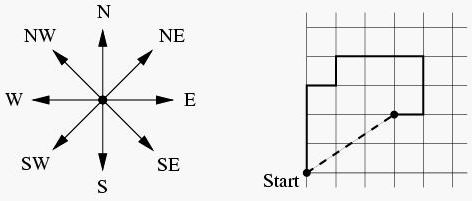G - There's Treasure Everywhere!解题报告(熊禾强)
来源:互联网 发布:阿里云优惠口令看不懂 编辑:程序博客网 时间:2024/04/27 18:04
题目大意:给出路径,求出终点坐标,和终点到起点的距离,其中路径有两部分组成,数字和字符,每个字符代表一个方向,数字代表在这个方向走的步数,每部长度为1;
解题思路:模拟走法
代码:
#include<stdio.h>#include<string.h>#include<math.h>const double PI=3.14159265359;int main(){int map=0;char a[10005];while(scanf("%s",a)!=EOF){ if(a[0]=='E' && a[1]=='N' && a[2]=='D') break;int i;double x=0.0,y=0.0;//定义起点for(i=0;i<strlen(a);i++){double s=0,c=1;if(a[i+1]=='.')break;while(a[i]<=57 &&a[i]>=48)//计算步数{s=s*c+(a[i++]-48);c=10;}if(a[i]=='N'&&a[i+1]=='E')//判断方向{x+=s*cos(PI/4);y+=s*sin(PI/4);}else if(a[i]=='N'&&a[i+1]=='W'){x+=s*cos(3*PI/4);y+=s*sin(3*PI/4);}else if(a[i]=='S'&&a[i+1]=='E'){x+=s*cos((-1)*PI/4);y+=s*sin((-1)*PI/4);}else if(a[i]=='S'&&a[i+1]=='W'){x+=s*cos(5*PI/4);y+=s*sin(5*PI/4);} else if(a[i]=='N')y+=s;else if(a[i]=='E')x+=s;else if(a[i]=='S')y-=s;else if(a[i]=='W')x-=s;}map++;printf("Map #%d\n",map);printf("The treasure is located at (%.3lf,%.3lf).\n",x+0.00001,y+0.00001);//加了那句+.000001才过的printf("The distance to the treasure is %.3lf.\n\n",sqrt(x*x+y*y));}return 0;}- G - There's Treasure Everywhere!解题报告(熊禾强)
- POJ-1473 There's Treasure Everywhere!解题报告
- POJ 1473 There's Treasure Everywhere!(简单几何)
- fjnu 1957 There's Treasure Everywhere!
- UVa 587 - There's treasure everywhere!
- POJ 1473 There's Treasure Everywhere! 笔记
- 百练1473:There's Treasure Everywhere!
- 解题报告(三):Zombie’s Treasure Chest 上海现场赛A题(hdu 4091)
- ZOJ 3209 Treasure Map 解题报告(Dancing Link)
- POJ 1066 Treasure Hunt 解题报告
- Problem G: 补提交 (解题报告)
- **Codeforces Round #282 (Div. 2) C. Treasure ACM解题报告(构造难题)
- HDU 5446 Unknown Treasure 解题报告(Lucas定理 + 中国剩余定理)
- G - Climbing Worm解题报告
- G - Monthly Expense解题报告(黄杰)
- G - The Fun Number System解题报告(贺奕凯)
- G - Islands and Bridges解题报告(来自网络)
- Goldbach's Conjecture 解题报告
- B - Scrambled Polygon
- C - How I Mathematician Wonder What You Are!解题报告(来自网络)
- D - Area解题报告(熊禾强)
- E - Pipe解题报告(来自网络)
- F - Pipe Fitters解题报告(熊禾强)
- G - There's Treasure Everywhere!解题报告(熊禾强)
- H - Area in Triangle解题报告(熊禾强)
- I - I Think I Need a Houseboat解题报告(熊禾强)
- J - Transmitters解题报告(熊禾强)
- K - Parallelogram Counting解题报告(来自网络)
- L - Pyramids解题报告(熊禾强)
- M - Toy Storage解题报告(来自网络)
- N - TOYS解题报告(来自网络)
- xp关机会自动重启的解决



